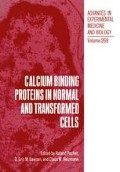Abstract
Our laboratory is interested in understanding the developmental regulation of the Ca2+-binding protein, parvalbumin, in embryos. We wish to learn how the various members of the parvalbumin gene family are differentially expressed, and what the individual isoforms contribute to muscle cell structure and function. Parvalbumin is a member of the troponin C superfamily and is evolutionarily related to a number of Ca2+-binding proteins, including calmodulin, troponin C., regulatory myosin light chains, oncomodulin, intestinal vitamin D-dependent calcium-binding protein, and Spec 1 protein (Goodman et al., 1979; Kretsinger, 1980; MacManus et al., 1983; Hardin et al., 1985).
Access this chapter
Tax calculation will be finalised at checkout
Purchases are for personal use only
Preview
Unable to display preview. Download preview PDF.
Rerefences
Celio, M.R. and Heizmann, C.W., 1982, Calcium binding protein parvalbumin is associated with fast contracting muscle fibers. Nature, 297:504.
Crow, M.T. and Stockdale, F.E., 1986, Myosin expression and specialization among the earliest muscle fibers of the developing avian limb, Dev. Biol., 113:238.
Dawid, I.B., Kay, B.K. and Sargent, T.S., 1983, Gene expression during Xenopus laevis development, in: “Gene structure and regulation in development”, pp. 171–182. S. Subtelny and F.C. Kafatos, eds., Lis, Inc., New York.
Dudek, F.E., Ide, C.F. and Tompkins, R., 1987, Unresponsive, a behavioral mutant in Xenopus laevis. Electrophysiological studies of the neuromuscular system. J. Neurobiology. 18:237.
Gauthier, G.F., Lowrey, S. and Hobbs, A.W., 1978, Fast and slow myosin in developing muscle fibers, Nature. 275:25.
Gillis, J.M., Thomason, J., Lefevre, J. and Kretsinger, R.H. 1982, Parvalbumins and muscle relaxation: a computer simulation study. J. Muscle Res. Cell Motility. 3:377.
Goodman, M., Pechere, J.-F., Haiech, J. and Demaille, J.G. 1979, Evolutionary diversification of structure and function in the family of intracellular calcium-binding proteins. J. Mol. Evol., 13:331.
Haiech, J., Derancourt, J., Pechere, J.-F and Demaille, J.G. 1979, Magnesium and calcium binding to parvalbumins: evidence for differences between parvalbumins and an explanation of their relaxing function, Biochemistry, 18:2752.
Hardin, S.H., Carpenter, C.D., Hardin, P.E., Bruskin, A.M. and Klein, W.H., 1985, Structure of the Sped gene encoding a major calcium-binding protein in the embryonic ectoderm of the sea urchin Stron-gylocentrotus purpuratus. J. Mol. Biol., 186:243.
Heizmann, C.W. and Berchtold, M.W., 1987, Expression of parvalbumin and other Ca2+-binding proteins in normal and tumor cells: a topical review. Cell Calcium. 8:1.
Heizmann, C.W., Berchtold, M.W. and Rowlerson, A.M., 1982, Correlation of parvalbumin concentration with relaxation speed in mammalian muscles, Proc. Natl. Acad. Sci., 79:7243.
Kay, B.K., Shah, A.J. and Halstead, W.E., 1987, Expression of the Ca2+-binding protein, parvalbumin, during embryo development of the frog, Xenopus laevis. J. Cell Biol., 104:841.
Kay, B.K., Schwartz, L.M., Rutishauser, U., Qui, T.H. and Peng, H.B., 1988, Patterns of N-CAM rexpression during myogenesis in Xenopus laevis. Development. 103:463.
Klug, G., Reichmann, H. and Pette, D., 1985, Decreased parvalbumin contents in skeletal muscles of C57BL/6J (dy2J/dy2J) dystrophic mice. Muscle Nerve. 8:576.
Kretsinger, R.H., 1980, Structure and evolution of calcium-mediated proteins, CRC Crit. Rev. Biochem., 8:119.
Lawrence, J.B. and Singer, R.H., 1986, Intracellular localization of messenger Rnas for cytoskeletal proteins, Cell, 45:407.
MacManus, J.P., Watson, D.C. and Yaguchi, M., 1983, The complete amino acid sequence of oncomodulin -a parvalbumin-like calcium-binding protein from Morris hepatoma 5123tc. Eur. J. Biochem., 136:9.
Melton, D.A., Krieg, P.A., Rebagliati, M.R., Maniatis, T., Zinn, K. and Green, M. R., 1984, Efficient in vitro synthesis of biologically active RNA and RNA hybridization probes from plasmids containing the bacteriophage Sp6 promoter, Nuc. Acids Res., 12:7057.
Nieuwkoop, P. and Faber, J., 1967, “Normal tables of Xenopus laevis (Daudin)”, 2nd ed. North-Holland Publishing Co., Amsterdam.
Peng, H.B. and Nakajima, Y., 1978, Membrane particle aggregates in innervated and noninnervated cultures of Xenopus embryonic muscle cells, Proc. Natl. Acad. Sci. USA. 75:500.
Reinschmidt, D.C. and Tompkins, R., 1984, Unresponsive, a new behavioral mutant in Xenopus laevis, Differentiation. 26:189.
Schwartz, L.M. and Kay, B.K., 1988, Differential expression of the Ca2+-binding protein parvalbumin during myogenesis in Xenopus laevis. Dev. Biol., 128:441.
Stuhfauth, I., Reininghaus, J., Jockusch, H. and Heizmann, C.W., 1984, Calcium-binding protein, parvalbumin, is reduced in mutant mammalian muscle with abnormal contractile properties, Proc. Natl. Acad. Sci. USA. 81:4814.
Towbin, H., Staehelin, T. and Gordon, J., 1979, Electrophoretic transfer of proteins from polyacrylamide gels to nitrocellulose sheets: procedures and some applications, Proc. Natl. Acad. Sci. USA. 76:4350.
Wnuk, W., Cox, J.A. and Stein, E.S., 1982, Paralbumins and other soluble high-affinity calcium-binding proteins from muscle. in: “Calcium and Cell Function”, vol. II. pp. 243–278. W.Y. Cheung, ed., Academic Press, New York.
Author information
Authors and Affiliations
Editor information
Editors and Affiliations
Rights and permissions
Copyright information
© 1990 Plenum Press, New York
About this chapter
Cite this chapter
Kay, B.K. (1990). Parvalbumin Expression in Normal and Mutant Xenopus Embryos. In: Pochet, R., Lawson, D.E.M., Heizmann, C.W. (eds) Calcium Binding Proteins in Normal and Transformed Cells. Advances in Experimental Medicine and Biology, vol 269. Springer, Boston, MA. https://doi.org/10.1007/978-1-4684-5754-4_31
Download citation
DOI: https://doi.org/10.1007/978-1-4684-5754-4_31
Publisher Name: Springer, Boston, MA
Print ISBN: 978-1-4684-5756-8
Online ISBN: 978-1-4684-5754-4
eBook Packages: Springer Book Archive

